In the mid-1990s, the riverain North-West community of Morawhanna was buzzing with activity on any given day but as the water levels rose in the Barima River, the community today resembles a ghost town.
Morawhanna is located along the left side of the river, some 6 hours by boat from the Venezuela border and was once a popular village, not only because of its position as a stop-off point for travellers to that part of the North West District but also because of its economic possibilities, including fishing, farming and trading in fuel.
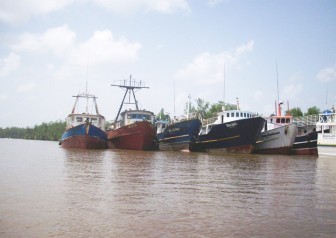
It was once a sprawling community which was earmarked to house the regional administration offices which are now located upriver at Mabaruma.
Today the community is home to about a dozen families with a population of fewer than 100 persons, most of them young children and adults of middle age; according to residents, most persons leave the community in their teens. Others in their prime also chose to move on to more fertile land elsewhere in the region and further afield.
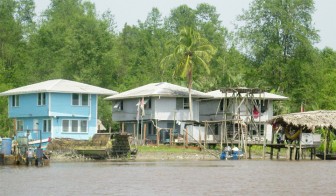
Recently, those who remain told Stabroek News during a visit that they will remain at Morawhanna until Mother Nature calls it a day for the community’s survival.
Morawhanna resident Rebecca Roberts said that she has lived there almost all of her life. The housewife related that during the 1990s the community was thriving and persons were eager to develop the area, even though there were already signs that the river could take a toll on the settlement.
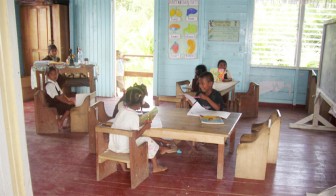
“Most people gone away: the Leungs and Mr Frank others who are well-known here… because this whole area get covered with water,” Roberts said as she sold a customer two ‘cool downs’ from her home which is linked to the small narrow roadway by a small wooden bridge. She said most residents at Morawhanna today live with a sliver of hope that one day the authorities will invest in the village and in particular undertake critical river defence work to save the area.
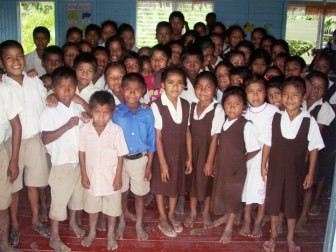
She said that many times during the year, especially during spring tide, the entire community is swamped, and the few activities in the area grind to a halt. “It bad and I could recall last year around Diwali this whole place… even up to my step been under water so one could imagine,” she told this newspaper.
‘People will always remember Morawhanna’
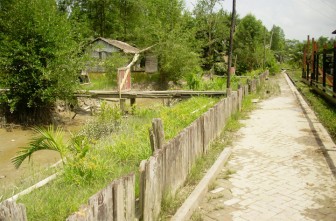
Roberts is not the only person who plans to stay. A few yards down the small track where parts of the main claybrick road can still be seen, farmer Stanley Alexander and his family vowed that they will “be around here till it impossible.”
An optimistic Alexander told Stabroek News on a sunny afternoon last week that he and his wife and their children will remain there. He said that while the community is threatened by the river, “what we gon do pardna? We can’t fight God but I mean if they [government] did do something earlier this place as I know it woulda been different.”
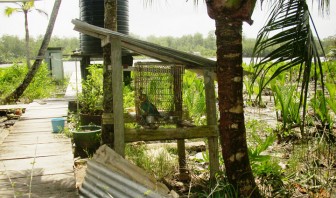
Alexander is self employed and sells fish and farm produce to supplement his family’s income. He said he regards life as very comfortable given the circumstances. He said Morawhanna will always be a household name around the country and “even if the river covers this place; people will always remember Morawhanna.”
South along the waterfront lies the Morawhanna Primary School, which houses nursery and secondary departments. As one enters the school compound, the loud voices of the two teachers there penetrate the surroundings.

According to a teacher at the school, some 72 children, mainly from Morawhanna, attend the institution, while others travel from nearby communities along the Barima River as well as Smith’s Creek, located across the river from Morawhanna.
Classes are held in an open area, with small passageways separating the classes. Children could be seen busy working on their lessons. Most were well attired, and even though many wore no shoes, they all appeared eager to learn. “They are usually punctual and attend school almost every day,” a teacher noted.
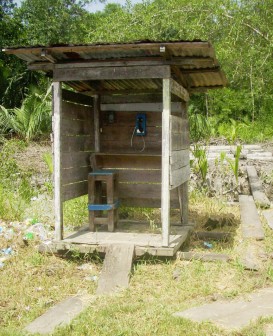
The school was once housed in a much larger two-flat building aback of the community but the facility also lost its fight with the water. Sitting behind the school was an excavator which an elderly resident told Stabroek News “was suppose to somehow save we.”
He said less than a week after the machine was taken to the area, it developed mechanical problems and has been at its present location since then. “You see the whole problem with this area is drainage and irrigation, and some years ago they have a sluice door north of the community which been giving problems,” he said. The man went on to explain that the structure has since been inoperable and the community’s survival rests with it being repaired as well as with critical revetment works.
“Bhai like they forget this place, and I could tell you only God will know what to do with Morawhanna because it’s a place like no other,” the man stated with a laugh.
The GDF Coast Guard and the Guyana Police Force all have established bases at the legal port of entry but despite their presence, residents noted, the area is a haven for illegal activities, mainly at night.

At the moment a private oil company owned by a Trinidadian national has taken over the oil storage facilities in the waterfront community and several boats laden with empty drums sat alongside the berth as they awaited fuel during this newspaper’s visit last week. The fuel is sourced from Venezuela.
The oil facility was once operated by GuyOil Company but the company closed the operation several years ago citing unfair competition from smugglers who ply their trade across the border to Venezuela. There was also a fisheries complex which stood at the waterfront and was popular for its services to fishermen, who travelled there from as far as the Essequibo Coast to buy ice in order to preserve their catch.
The two North West ferries, the aged MV Lady Northcote and the MV Kimbia as well as vessels ferrying cargo and tugs with barges in tow also stop at Morawhanna on their way to neighbouring Kumaka and Port Kaituma. The penultimate stop usually brings a sigh of relief as passengers can access snacks and beverages, including coconut water, in the community.




